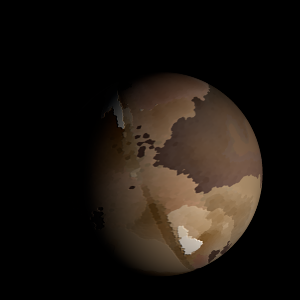| Fictional info (?) |
|---|
| Suggested name | Julto Mosiso |
| Planet type | Hot planet |
| It has the longest rotation period (445 days) of any planet in its solar system and rotates in the opposite direction to most other planets.
As seen relative to the fixed stars, it rotates on its axis exactly four times for every five revolutions it makes around Kepler-318.
It may have had argon oceans in the past, but these would have vaporized as the temperature rose due to a runaway greenhouse effect. The argon has probably photodissociated, and the free ammonia has been swept into interplanetary space by the solar wind because of the lack of a planetary magnetic field. |
| Atmosphere | Ammonia | 49% |
| Helium | 37% |
| Argon | 6.5% |
| Molecular hydrogen | 2.8% |
| Nitrogen | 2.4% |
| Xenon | 0.45% |
| Nitric oxide | 0.38% |
| Methane | 0.31% |
| Water vapor | 0.012% |
| Neon | 0.00032% |
| Atmospheric pressure | 12 bar |
 |
| Moon | Dasyco | Large potato shaped rocky planetoid |
| Perly-euke-qeqher | Medium-sized slightly egg-shaped gaseous moon |
| Rheapo-ma | Very small almost round gaseous planetoid |
| Teadeuces | Huge round rocky asteroid |
| Sidaketi Idtur | Medium-sized round gaseous comet |
| Laris Thrymr | Medium-sized potato shaped oceanic asteroid |
| Hethea Farche Poly | Large irregular rocky planetoid |
| Steariel Teathea | Large round crater-filled asteroid |
| Skoll | Very small irregular oceanic moon |
| Antoprax Remone | Large round crater-filled moon |
| Bautihe-li | Small irregular rocky moon |
| Lislia Moon | Huge irregular rocky moon |
| Tosope | Very small round rocky moon |
| Steph-farilas Si | Large round rocky asteroid |
| Thrymr-rok | Huge slightly egg-shaped crater-filled moon |
| Onetrin | Large almost round crater-filled moon |
| Dene | Medium-sized almost round crater-filled asteroid |
| Silirr Ladecal Li | Large round rocky asteroid |
| Aden-lysaxa | Small irregular ice comet |
| Cheraxgreip | Huge slightly egg-shaped rocky comet |
| Herme | Large potato shaped ice planetoid |
| Bebio Mede Vos | Large almost round gaseous asteroid |
| Calipero Ro | Large potato shaped rocky asteroid |
| Seariel Best | Large irregular oceanic asteroid |
| Tetides Heliapa | Medium-sized slightly egg-shaped ice moon |
| Noeme Julymir | Very small slightly egg-shaped ice planetoid |
| Poly Ceeury | Huge irregular rocky moon |
| Noemi Ketis-tri | Medium-sized almost round gaseous asteroid |
| Edeporie | Medium-sized slightly egg-shaped crater-filled moon |
| Paja Naqly-rhea | Huge round rocky asteroid |
| Nethy | Very small potato shaped rocky comet |
| Trinkal'saothe Hi | Large round rocky comet |
| Bebke Mona | Very small round rocky moon |
| Phaëper Ca | Small almost round gaseous moon |
| Patay-fen | Huge round oceanic moon |
| Google search for Julto mosiso |